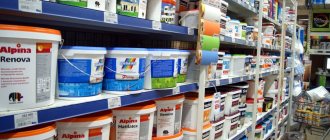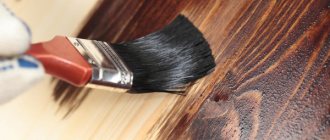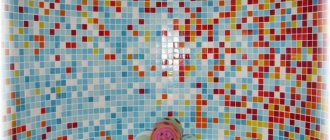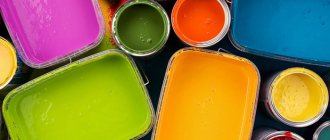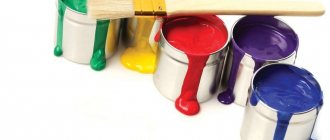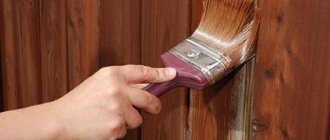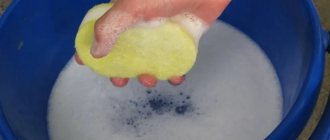Repair requires a lot of effort and time to make a high-quality update of the interior of an apartment or house. For this reason, many property owners want to reduce some of the work, especially when it comes to carrying out the finishing stage with their own hands. If the surface of the walls was previously painted, then beginners wonder: is it possible to apply paint over paint? The consequences of this decision, and in what cases this is permissible, will be discussed below.
Can paint be applied to paint?
Professionals do not recommend painting over another coloring material. For them, the stage of removing the old finish is mandatory. The reason is the danger of peeling off the previous coating, and if you apply a new layer on it, it will suffer along with the old one.
Having painted a light color on top, there is a high probability of noticing dark spots appearing through it. All flaws in the previous finish will be noticeable. In addition, not all paints and varnishes are compatible; their components may not fit each other, the layer will not apply well, and the degree of adhesion will be low.
Applying one layer to another is permissible only if the first one is in good condition, if it is perfect and lies securely on the surface. It is advisable to use similar paints and varnishes; it is optimal to paint the wall with the same types of paints.
For professionals, the stage of removing the old finish is mandatory.
What is the function of the primer?
As already mentioned, primer ensures reliable adhesion of paint to metal. It acts as an intermediate layer, a connecting link, so to speak. But this definition is valid only in general terms, because there are different types of primers that have certain properties.
Main types of soil:
There are also primers that combine various properties. They are called universal. Therefore, if you don’t know what kind of primer you need to coat your car with before painting, then choose a universal one. Acid and epoxy primers are classified as special primers.
The fill primer contains bulk particles that form a porous layer with high adhesion on the body. This layer fills in all the small defects left after grinding (washing). Filling soil can also be sanded, but the risk is so small that it is not visible to the naked eye.
The stability of the entire paint coating depends on how well the filling primer adheres to the metal. The better the primer, the better the paint will adhere. You should not skimp on primer if you are making a car for yourself. By and large, you shouldn’t do this, even when the car is being prepared for sale, because palming off a person who gives you a considerable amount of money is, at a minimum, dishonest.
Acid primers are not an alternative to fillers. The acids they contain react with the metal, forming a sealed coating of oxides. This coating has anti-corrosion properties. If the body is stripped down to metal, then treatment with acid primer will be very useful.
Epoxy primers form an impermeable layer on the surface. They preserve the underlying layers and at the same time have excellent adhesion. They can be applied both to metal and to primer or putty. Epoxy primers help seal materials and separate layers.
What kind of paint can be applied to oil paint?
If you need to paint in a short time and there is no way to waste time on removing the old finish, then there is an option when the paint layer can be applied to another one. You should check the integrity of the coating and whether it adheres firmly to the base.
The assessment is made visually; you should also run your hand over the surface; swelling can be detected using this method. If there are large defects, you cannot think about applying a new layer. Such a surface will repel new material quickly.
The oil composition has a glossy structure; it is the creation of an even film that helps protect the surface from moisture, for this reason it is often used for wood. But a smooth surface is not suitable for obtaining a good degree of adhesion. Therefore, the use of re-staining is difficult.
It would be correct to remove the paint; for this purpose, you can find special removers on sale; they soften the layer, after which you can remove the paint with a spatula. The process is not fast, but you get a good basis for repairs
If the base is in good condition, and you still decide to paint, then oil or alkyd enamel is more suitable for an oil base. You can also resort to acrylic; you will need to carry out the preparatory stage, applying a primer.
Compositions based on water are not a suitable option; in order to complete the polymerization, it is necessary to saturate the surface with water, and an oil coating will not allow it to pass to the base, so drying will not take place at the proper level, and reliable adhesion will not be obtained.
The oil composition has a glossy structure; it is the formation of an even film that helps protect the surface from moisture.
Young fighter course
We're going to focus on unconventional painting methods. However, it's worth starting with the basics.
How to paint various surfaces correctly?
Without a clear understanding of this, it is difficult to know which deviations from standard procedure are acceptable and which should be avoided.
- All old paint and varnish coatings are stripped down to a solid base.
Please note: the base must be stronger than the coating. Violation of this simple rule most often leads to paint peeling.
- The surface is cleaned of all kinds of contaminants, dust, rust and degreased..
- Then the surface to be painted is primed . Primers have greater adhesion to substrates and provide more reliable adhesion between them and paint.
- Finally, the dye itself is applied - usually in several very thin layers . If necessary, thickened paint is diluted with an appropriate solvent: two or three thin layers dry faster and are more durable than one thick one.
In addition, it is worth paying attention to several nuances.
- Coatings adhere better to rough substrates. If the surface is glossy, it is first subjected to rough grinding. Smooth metals are often etched before painting.
Phosphating primer VL-02 transforms the metal surface to improve its adhesive properties.
- Excessive absorbency of the surface to be painted leads to unnecessary waste of dye. Before painting in such cases, the use of penetrating primers is justified. They fill the largest pores, at the same time binding the top layer of the base and increasing its strength.
Now let's move on to difficult situations and exceptions to the rules.
Is it possible to paint with oil paint over oil paint?
Is it possible to paint with oil paint over oil paint? Many property owners who decide to refresh the color of the walls ask this question. This option is optimal if you need to skip the stage of removing the old coating. To get better adhesion, it is advisable to sand the base, removing the glossy layer.
To get better adhesion, it is advisable to sand the base, removing the glossy layer.
Is it possible to paint with acrylic paint over oil paint?
The question of whether it is possible to paint with acrylic paint over oil paint can be answered in the affirmative. But a special type must be used - Master 121 paint. Taking into account that the surface has no flaws, the layer does not peel off or crack, only such a wall can be re-painted.
Master 121 is an acrylic enamel that is distinguished by its high adhesion to any type of substrate; it can even be applied to a glossy surface. This product will help to obtain a reliable and strong adhesion of the product to oil-type acrylic. But even the quality of good adhesion requires preliminary preparation of the base:
- First of all, the surface is sanded; fine-grained sandpaper is used for this purpose.
- The wall is washed, all dirt and grease should be removed.
- The surface must dry completely before painting; after the required time has passed, the wall is painted.
To improve the result, an equal amount of water should be added to the paintwork material; applying a more liquid product will make it easier to obtain an even and uniform distribution of the composition.
If you intend to distribute paint over the wall with a spray bottle, then you need to dilute it with special solvents.
Master 121 is an acrylic enamel that is distinguished by its high adhesion to any type of substrate.
The surface has imperfections
How to determine if a surface has minor flaws:
- some places “bubble” (no more than 10% of the affected area of the total);
- there are small cracks;
- noticeable areas where the coating has begun to peel off.
In case of minor damage, it is allowed not to completely dismantle the old layer. Only unreliable areas of paint will have to be removed. As a rule, it can be cleaned using a regular spatula. Places where there is good grip do not need to be touched. Next, you need to process the cleaned areas in the classic sequence:
- primer and putty,
- sanding using coarse and then fine-grained sandpaper (the level should be the same as the rest of the surface);
- another coat of primer.
Only after all this can you cover the walls or ceiling with water-based paint over the old layer. If the surface is not leveled well enough, the flaws will be very noticeable, so the main emphasis during preparation should be placed on this stage.
New painting involves applying two or three layers, the first of which, as in the situation described above, will become a primer.
It is very important to properly remove old peeling paint from the wall.
Is it possible to paint with alkyd paint over oil paint?
Often windows, radiators, ceilings and walls are painted with oil-based compounds. However, modern technologies have made it possible to create more advanced types of paints, for this reason many want to replace the material. Alkyd enamel has many advantages.
If an alkyd resin-based paint is chosen to repaint the paint, then the old oil-based coating must be removed. Only if the previous finish is securely fixed can re-painting be allowed.
Then the wall is sanded, the remaining dust and dirt after the process is washed off with an aqueous solution with soda. After the base has dried, the finished solution can be applied; several layers will be required, it is important that each of them is completely dry.
If an alkyd resin-based paint is chosen to repaint the paint, then the old oil-based coating must be removed.
Painting the ceiling
If it was decided not to remove the old coating, then some work will still have to be done.
Preparatory work
At this stage, it is recommended to carefully inspect the ceiling covering and assess its condition. Experts recommend using special lighting “at an angle”, this will reveal all the flaws. If there are serious defects on the ceiling, then it is necessary to remove the exfoliated elements, apply putty to those places where there are deep potholes and treat everything with a primer.
Important! If you find mold on the ceiling, you must get rid of it and treat the area with a special impregnation that will prevent the spread of spores.
The prepared ceiling dries quite quickly. For example, if you applied primer in the morning, then after lunch you can start painting. The second layer of water-based emulsion (if necessary) is usually applied the next day.
Painting
The work of applying a fresh layer of water-based paint over the old layer looks like this:
- We prepare the necessary tools. To work, you will need a brush 3-4 cm wide, a roller, a paint tray (cuvette), a rag and a telescopic handle. You also need masking tape and polyethylene (or you can buy a special covering material with adhesive strips).
- We cover the furniture and floor with polyethylene.
- We study the instructions for the selected paint. Some formulations are sold ready-made, others require dilution with water. In addition, you may need to add pigment (color) if you plan to create a colored ceiling covering. It is also important to adhere to exact proportions, as they may differ depending on the manufacturer of the coloring composition.
- Pour the required amount of paint into the cuvette. We dip the brush into the composition, blot it so that the paint does not run off and thoroughly treat all the corners and joints. Also, using a brush, decorative elements made of plaster, if any, are processed.
- We take a roller and begin processing the ceiling. In the wide part of the cuvette, the roller is wetted, and in the narrow part it is blotted and rolled several times so that the paint is evenly distributed over it.
- Moving the roller in parallel movements, we begin to apply the composition. It is necessary that each subsequent strip overlaps the previous one by half.
- If you need to add another layer, then this should be done the next day. Experts recommend applying the finishing layer parallel to the window or other light source. To do this, you should use a new, soft and better quality roller attachment. This will give you a smoother finish.
If the previous coating is damaged or is a whitewash, then it is better to remove it.
Is it possible to paint with enamel over acrylic paint?
The acrylic type is distinguished by the presence of water in the composition, which contributes to the environmental friendliness of the composition, it does not smell unpleasant, and also does not emit harmful components when drying. The presence of water makes it possible to paint over other paints and varnishes, including enamels. First you need to clean the wall of dirt and apply a primer, then adhesion will be better. Of course, such finishing is only possible on strong substrates, without cracking.
The presence of water makes it possible to paint over other paints and varnishes, including enamels.
Is primer needed when painting a putty part?
Some craftsmen, in order to save money, try to paint completely puttied parts without primer. But the savings are negligible, meanwhile the quality of the painting suffers. The fact is that it is unlikely that it will be possible to wash off the putty so that after painting no risk appears. Usually they also add a developing layer to bring the polishing to perfection.
The pore size of filling primers is much smaller than that of automotive putties. Accordingly, the primer washes out much better. In addition, it fills in all surface defects of the putty itself. Therefore, it is necessary to prime the putty.
How to paint walls with water-based paint over oil-based paint
The water-based composition is also produced using water. To obtain the necessary fixation of the layer, it must be saturated into the base. But the oil composition will not give water such an opportunity, it will simply push it away from itself.
For this reason, part of the layer will adhere well, in those places where the gloss has come off, and part will simply not adhere. To avoid such consequences, apply a layer of drying oil; it will create a good base for adhesion. Or a primer solution is used.
To obtain the necessary fixation of the layer, it must be saturated into the base.
What kind of paint can acrylic paint be applied to?
To paint an oil base with an acrylic composition, first apply a primer mixture; it will create the necessary level of adhesion of the two products. The water-based base must be ideal, then it will be possible to apply an acrylic-based product. But it is always better to remove the previous finish. Then the coloring will be of high quality.
It is possible to use a latex layer on top; it is important that the acrylic is of high quality. Then the degree of adhesion will be good, the compositions will be able to adhere well.
It is possible to use a latex layer on top; it is important that the acrylic is of high quality.
Is it possible to paint with oil paint on nitro enamel?
The oil type of wall painting material has an oily structure that is poorly compatible with nitro enamels. If you apply them on top of each other, the following problems may appear:
- Formation based on cracks and bubbles;
- Changing the shade of the product, which ultimately will not allow you to get the desired design of the room;
- The paint life will be short.
The oil type of wall painting material has an oily structure that is poorly compatible with nitro enamels.
Types of water emulsion
All paints belonging to this category are water emulsions, which consist of pigment particles and binding components. Today you can find many varieties of such compositions on sale:
- Acrylic. This is the most popular option, which is used for residential premises. It is easy to guess that acrylic resins are present in such mixtures. This water emulsion also contains latex additives. All this makes acrylic paint durable and resistant to moisture. Due to its high elasticity, it hides unevenness of the old coating well and penetrates into cracks no more than 1 mm wide.
- Silicone. These are waterproof and resistant water-dispersed compositions, which are essentially an intermediate form of chemically pure organics and substances of inorganic origin. As a rule, they are used for bathrooms and other rooms with high humidity. Silicone resins make it possible to create a reliable coating, but it should be noted that such water-based emulsions are not suitable for ceilings if there are large defects on it. This paint is used if there are cracks on the surface of the spruce tree no more than 2 mm wide.
- Silicate. These compounds resemble silicone ones. Only in this case the basis is liquid glass. Additionally, the composition may contain silicon-organic resin. However, they are very expensive, and their characteristics are more than enough for a residential area, so they are most often used in the industrial sector.
Healthy! If we talk about the best manufacturers, then among the most expensive paints of this type it is worth highlighting the products of Kaporol and Dufa. From the middle price segment, preference should be given to Tex paints.
Is it possible to paint with oil paint on enamel?
Oil base and enamels are similar in their components, which helps to use them together. If necessary, the formulations can be mixed together. It is also allowed to paint them on top of each other.
But the condition for the reliability of the base remains unchanged for any composition. The surface should be cleaned of all types of contaminants and thoroughly degreased. The new product should be applied in several layers. The importance of drying each one is undeniable, so don’t rush, otherwise the paint will be ruined and won’t last long.
The new product should be applied in several layers.
The article provided a detailed answer to the question: is it possible to apply paint to old paint? The technology of work includes the mandatory removal of old materials, but sometimes it is not possible to carry out this stage. Then the condition of the surface is assessed and compatible products are selected.
